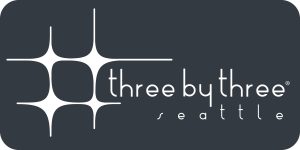By Vicki Matranga, Design Programs Coordinator
Get to know the people behind the stylish, thought-provoking designs that will be exhibited in Discover Design. This series of conversations will give you a glimpse of the inspirations, influences and ideas that go into creating the exciting products that you’ll see there at the 2013 Show.
We’re speaking with designer Gwen Weinberg who creates products for Three by Three, Inc., based in Seattle, Wash.

Where do you find inspiration when designing new products?
Our design process always begins with a question: what do we ourselves need in our own offices and organizing areas? Efficiency is a key point and drives our design challenges – we know the value of space and always try to consolidate several functional features into one product. The trick is finding the balance between the look and the functionality…. where is that sweet spot where a product has enough features to be highly useful, but not so overdosed as to make it clunky and cluttered; designs need to work well, but equally need to be worthy of being displayed.
Are there any specific designers, places or eras that influence you?
The one designer who has had the most impact on my personal design direction is one of the classics of mid-century modern design, George Nelson. He is my inspiration for achieving simple, bold, elegant and functional design solutions.
How do you choose which idea to take to the next step – to product development?
After a few rough prototypes are made of various designs, and quotes come in from our partner factories, we’ll consider which are feasible. From there we’ll make “real” prototypes using the intended materials, and we’ll test these at home and at work. We’ll improve upon them as we use them, seeing what works and what doesn’t, what looks good in-use and what needs tweaking.
How do you identify the key user audience for your products?
College-educated women are the majority of our user demographic.

Is there an approach or look that joins the functionality, form or emotional appeal of your product line?
For larger office products we’re using alternative materials and surfaces that had previously been used only in furnishings and high-end kitchens. Bulletin boards are no longer simple framed cork; instead we now have sleek stainless or powder-coated magnet boards. Whiteboards are no longer boring, plain and lifeless; instead we have sleek glass and brushed stainless, bamboo and brightly colored dry erase boards. The home office trend has yielded a completely new product type: family organizing centers… multi-functional communication hubs where the family can create and find schedules, write notes and reminders, hang keys, store mail. This has driven many of our newer designs.
For smaller office accessories, we go bright! Makes a great pop against a more neutral home decor. As with larger items in any modern home, these small details need to look good without compromising functionality. This mentality has inspired all of our lines of strong magnets and magnet hooks. We don’t jeopardize strength for the sake of design, or vice-versa. A good magnet should satisfy both demands equally well.
How do you see design’s importance in our industry as it moves forward?
More and more we are seeing the office or organizing space take on a prominent role in the family home, whether it’s carved out in a kitchen or den, or a separate room altogether. Having a well-designed home office is becoming a new focus, especially given its high visibility with the rising popularity of open floor plans. As a result, office products are trending toward fitting into modern home decor. Now, instead of purely functional items for the workplace, office products are taking on a dual role as a piece of furniture or a decorative accent. As we look ahead, we can see the home-office niche market growing. The new economy is finding more people at home, working remotely, starting small businesses, and needing to manage the family and household more effectively and efficiently. Our hope is to continue to create tools and solutions that not only meet this growing need but also push the office product design boundaries.
Where are your products manufactured?
China
How does Discover Design help to expand your brand?
It certainly exposes us to a design-sensitive market. It’s clear Discover Design has been carefully curated and the results are obvious as you walk the vast halls of the Housewares Show… the area really stands out. It’s great to be part of a section which highlights and illuminates manufacturers that have focused on the importance of design in home and office products.
What advice can you offer to designers working in the home goods field?
Try to find a gap in the market – a need that hasn’t been met successfully – and create a clever, well-designed solution.
Thank you, Gwen, for taking the time to outline your process and inspiration. Your appealing products speak to a growing need in the home. We look forward to seeing more at your booth S3871. Learn more about their products at www.threebythree.com

Discover Design is the premier design destination at the International Home + Housewares Show. Located in the South Building, within the Dine + Design Expo, the invitation-only category features more than 100 exhibitors from around the world. Companies driven by innovation and inspired by design present distinctive products and collections in Tabletop, Gift, Textiles and Home Décor. Exhibitors are selected to participate by a panel of industry experts comprised of retailers, design journalists and peers. Some exhibitors appeared here last year, many are new to our Show. The Discover Design Gallery, accessible to buyers and media, features select products that are entries in the gia Global Innovation Award for Design. Learn more about Discover Design exhibitors and their products by checking Housewares Connect 365 at www.housewares.org


